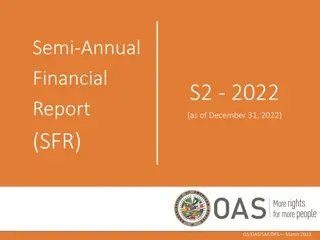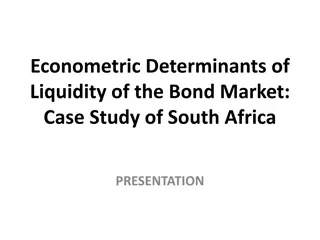Proportionality Principle in Liquidity Risk Management
The concept of proportionality is essential in evaluating measures related to liquidity risk management in the banking sector. The principle emphasizes the necessity for measures to be appropriate, necessary, and not disproportionally disadvantageous. By applying a 3-stage test, institutions can ensure that their liquidity rules are legitimate, effective, and fair. The importance of balancing regulatory requirements with potential costs and effects on stakeholders is highlighted, along with the consideration of compliance costs and social implications in the context of financial stability.
Download Presentation

Please find below an Image/Link to download the presentation.
The content on the website is provided AS IS for your information and personal use only. It may not be sold, licensed, or shared on other websites without obtaining consent from the author. Download presentation by click this link. If you encounter any issues during the download, it is possible that the publisher has removed the file from their server.
E N D
Presentation Transcript
EBA proportionality workshop Proportionality and Liquidity Risk Andrea Resti Department of Finance Bocconi University andrea.resti@unibocconi.it
2 The proportionality principle: back to basics The lawfulness of a measure depends on whether it is appropriate and necessary to achieve the objectives legitimately pursued. When there is a choice between several appropriate measures the least onerous must be adopted, and any disadvantage caused must not be disproportionate to the aims pursued. A 3-stage test: 1. is the measure suitable to achieve a legitimate aim? 2. Is it necessary to achieve that aim or are less restrictive means? 3. Does it have an excessive effect on European citizens or companies?
3 The new Liquidity Rules: a legitimate aim? Aim: to avoid the costs caused to taxpayers, employees, consumers and borrowers by bank failures triggered by an inadequate liquidity profile (LCR) and/or by an excessive maturity transformation (NSFR) with a special focus on costs caused indirectly, through contagion Costs to shareholders Direct costs to other stakeholders Costs of contagion
4 The new Liquidity Rules: necessary and able to achieve this aim? The financial crisis has shown the weaknesses of a system based on Capital requirements Discretionary review by national authorities Market discipline (?) Hard limits to the banks ability to take on liquidity risks may therefore add significantly to the effectiveness of the regulatory framework
5 Disadvantages (dis)proportionate to the aims pursued? Two main classes of disadvantages Lower profitability and higher prices ex ante or ex post? Will shareholders lose the ability to outsource costs to the taxpayer? It is hard to ensure that this dilution in profitability / increase in prices is proportionate to disadvantages, but it is hard to challenge this in Courts Compliance costs Mainly fixed in nature although the rules can accommodate for some degree of flexibility (e.g., Pillar 1 in Basel 2) while the negative externalities increase with size!
6 On a micro basis, compliance costs may prove disproportionate to benefits Similar issues may arise in large international groups having small local affiliations Some compliance costs may be similar Social costs Social benefits Large banks generate larger systemic externalities Small bank Large bank
7 Keeping reporting costs aligned with benefits: what can be done? Art. 415.3: The reporting formats and frequencies shall be proportionate to the nature, scale and complexity of the different activities of the institutions , but Art. 415.1: Institutions shall report the LCR items not less than monthly and NSFR items not less than quarterly Art. 415.3: Eba shall specify uniform formats and IT solutions What scope for proportionality is left to EBA?
8 Keeping reporting costs aligned with benefits: scope for proportionality Frequencies? No. Remittance dates? Yes. This should be extensively used, also to ensure that tight remittance dates do not prove detrimental for the quality of the data provided by less sophisticated institutions The gap between different classes of institutions could be wide upon first-time application, then close as data collection processes are fine-tuned Formats and IT solutions? Yes. The level of detail may vary across different classes of institutions, provided that data can be reconciled at the less granular level 2-3 different IT solutions should not be ruled out, as far as they allow for data to be easily integrated Duplicated information flows Art. 412.5: Member States must remove national provisions when LCR is fully introduced in the Union (art. 460), but National NSFR until European NSFR is introduced (413.3) National monitoring tools until full introduction of EU liquidity rules (415.3)
9 Keeping reporting costs aligned with benefits: what else should be done Rules on liquidity subgroups strike a sensible balance between the host countries wish to control liquidity externalities and the need for strong, streamlined, integrated liquidity rules E.g., by setting minimum amounts of liquid assets to be held by local institutions (Art. 8) Still, they leave considerable room for national supervisors wishing to drag their feet Political consensus is needed to strengthen the EBA s powers of non-binding mediation (Art. 21) Otherwise, cost/benefit proportionality will be affected twice: Irrational cost duplication Costs following from constraints to the free flow of funds across cross-border groups
EBA proportionality workshop Proportionality and Liquidity Risk Andrea Resti Department of Finance Bocconi University andrea.resti@unibocconi.it






























